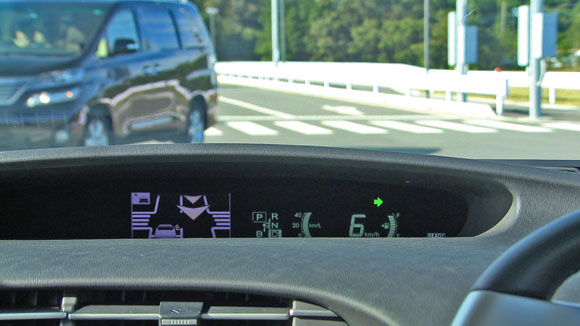Advanced new road car technology designed to reduce parking-speed collisions and high-speed rear-end shunts has been developed by Toyota.
The systems were unveiled on November 11th at the opening of a new proving ground in Japan, and are soon to be featured in Toyota production vehicles.
The new proving ground has been built specifically to test and develop so called “active” safety systems, including Integrated Transport Systems (ITS) that use radio communications between vehicles, road infrastructure and pedestrians to improve safety. We’ve listed the main announcements, below.
A large number of collisions are caused by drivers hitting the wrong pedal or selecting the wrong gear, particularly when parking. Toyota has come up with two new systems to help reduce the consequences when this happens.
[youtube width=”580″ height=”337″]https://www.youtube.com/watch?v=0fIRc6xw4EY[/youtube]
The Intelligent Clearance Sonar is able to detect obstacles that are outside the driver’s line of sight and will automatically apply the brakes if there is a risk of a collision. Designed to be particularly useful when negotiating a car park, it will sound an alarm, reduce engine power and apply the brakes.
Drive-Start Control recognises if the wrong gear has been selected when the driver is applying the throttle. It will flash up a warning and reduce engine output to limit a sudden start or acceleration.

This can help, for example, when a driver reacts to hitting an object while reversing by making a quick shift to a forward gear while still pressing the accelerator pedal.
Toyota is set to introduce both systems in future vehicles.
Pre-Crash Safety system with Collision Avoidance Assist
Toyota has further developed its Pre-Crash Safety system with a collision avoidance function that can help reduce the consequences of rear-end impacts, even at high speeds.

This version of PCS– a technology already featured on a number of Toyota and Lexus models – uses a millimetre-wave radar to monitor the risk of collision with a vehicle ahead. If it detects an impact risk, it triggers an alarm and warning display to alert the driver to apply the brakes. When the brake pedal is pressed, the system will increase the braking force to up to twice the average level achieved by drivers**. This can slow the vehicle down by up to 37mph* (60km/h). If the driver fails to step on the brakes, the system will automatically deliver deceleration*** of between nine and 19mph****.
Toyota’s analysis of traffic accident data shows that more than 90 per cent of rear-end collisions happen when the difference in speed between two vehicles is within 37mph, so it set out to engineer a system based on this intelligence to deliver industry-leading safety performance. Already, the technology is being prepared for use in forthcoming models.
Intelligent Transport System proving ground
Toyota has opened a new proving ground to test and evaluate its Intelligent Transport System technology. The site extends over 3.5 hectares at the Higashi-Fuji Technical Centre, creating a simulated city centre road system, complete with traffic signals.
[youtube width=”580″ height=”337″]https://www.youtube.com/watch?v=uwLE3csyDAc[/youtube]
It will allow Toyota to test a system for road-to-vehicle communications using a 700Mhz radio frequency in controlled but authentic traffic conditions. This transmission band has been approved by the Japanese government for ITS use, as it has the right reception breadth and quality to be suitable for connecting with vehicles at junctions and other locations where a driver’s view may be limited.

When the proving ground is fully operational,Toyota will accelerate its research and development of environmental systems to improve fuel efficiency and driver support systems that can help reduce the risk of accidents with pedestrians and other road users in urban traffic.
Toyota is also undertaking R&D of systems that allow for a continuous exchange of road-to-vehicle, vehicle-to-vehicle and pedestrian-to-vehicle information.
Notes…
* Calculated from US accident data.
** When the driver’s car is travelling at 50mph (80km/h) and the vehicle ahead at 12.5mph (20km/h).
*** Automatic deceleration at speeds of 9mph and higher.
**** When the driver’s car is travelling at 31mph (50km/h) and the car ahead at 12.5mph (20km/h). Operation may be affected by road and weather conditions.





This is great technology. Hopefully it will be available soon. I assume the Prius Plus will not have this as you can’t currently get the Pre-Crash Safety and adaptive cruise on the Prius Plus at the moment, although its available on the cheaper Prius. Pity really as if it was available i would now be a Toyota owner.